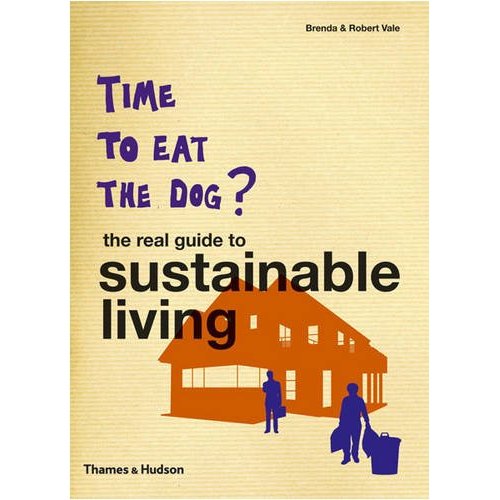“Time to Eat the Dog: The Real Guide to Sustainable Living” — The environmental cost of pets
December 22, 2009
Time to Eat the Dog? The Real Guide to Sustainable Living by Robert and Brenda Vale published this year in England raises the thorny question of whether or not you can justify the carbon foot print of your pet.
I’ve posted an excerpt of Thorstein Veblen’s thoughts on the extravagance of dogs here on the Cynodictis Project page. Veblen’s governing principle was that every expenditure about subsistence was “conspicuous consumption” a purchase whose real aim is to communicate something about the buyer. Owning a dog says to the world, in effect, I have so much income I can afford to waste a portion of it feeding and caring for a non-productive member of the household.
I’ve always thought of this concept in terms of useless rooms in houses. I grew up, at least part of the time, in a house which had a living room that was for show purposes only. The furniture wasn’t wrapped in thick plastic but no one used the room. It was understood. The dog was not allowed in there either, under any circumstances. The living room was for entertaining on a certain level. Evidently did not circulate with the other A-listers because our living room was used once a year or less.
But should we really eat our dogs as the Vales suggest? Even if we are feeling a bit peckish?
They calculate that a medium size dog eats around 360 pounds of meat and 210 pounds of cereal annually. They equate this with the energy consumption of driving a 4X4 SUV 6,200 miles a year, including the energy required to build the car. I don’t suppose that since our family owns only a single car, a Prius at that, it comes close to offsetting our two ravenous Labradors.
But that’s not the only negative impact our dogs have on the environment.
The Vales claim that dogs decrease the biodiversity in the areas they are walked. Why would the presence of a domesticated animal in a suburban environment (where most companion dogs live) decrease the local biodiversity? How much of a decrease and what’s the impact of that? I’d like to see and understand the science behind this contention.
They also say that dog feces are responsible for high bacterial levels in rivers and streams, ultimately killing off aquatic life. Again, this statement exists in a vacuum. Surely the run off of excrement from our present method of factory farming, especially chicken and pig farming, are a much greater factor in the fecal pollution of our waterways?
New Scientist magazine had an independent expert calculate the environmental costs of dog ownership and he came to the same conclusions as the Vales: “Owning a dog really is quite an extravagance, mainly because of the carbon footprint of meat.”
Obviously, someone like me is going to question the specific degree to which pet owning contributes to our use of limited resources. Every expenditure has costs. The point of this provocatively titled book is that every decision we make has an environmental impact.
For most of us this isn’t part of our calculation when considering a purchase, the way we wash our clothes or burial options. For example, I didn’t know that the biggest “cost” of clothes is in our continually washing them.
So I don’t think that anyone really wants you to consider eating your (probably delicious) dog. It makes for a grabber of a title, though.
Comments
Got something to say?
You must be logged in to post a comment.

